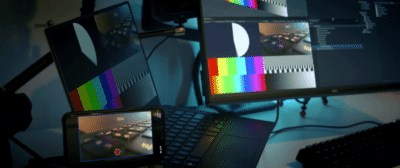KlakNDI is a Unity plugin that allows sending/receiving video streams between several devices using NDI®.
NDI® (Network Device Interface) is a standard developed by NewTek, Inc that enables applications to deliver video streams via a local area network. Please refer to ndi.tv for further information about the technology.
- Unity 2019.4
On Unity 2021.1 or earlier versions, KlakNDI requires the .NET Standard 2.0 profile -- You can't compile the package with the .NET 4.x profile.
From Unity 2021.2, KlakNDI is compatible with both the .NET Standard and .NET Framework profiles.
Desktop platforms:
- Windows: x64, D3D11/D3D12
- macOS: x64 or arm64 (M1), Metal
- Linux: x64, Vulkan
Mobile platforms:
- iOS: arm64, Metal
- Android: arm64, Vulkan
KlakNDI runs without the NDI SDK on most supported platforms, but only the iOS platform requires the SDK to build on Xcode. Please download and install the NDI SDK for iOS in advance of building.
-
Dimensions of frame images should be multiples of 16x8. This limitation causes glitches on several mobile devices when using the Game View capture method.
-
KlakNDI doesn't support audio streaming. There are several technical difficulties to implement without perceptible noise or delay, so there is no plan to implement it.
This package uses the scoped registry feature to resolve package
dependencies. Add the following lines to the manifest file
(Packages/manifest.json).
Unity 2021.1 or earlier
To the scopedRegistries section:
{
"name": "Unity NuGet",
"url": "https://unitynuget-registry.azurewebsites.net",
"scopes": [ "org.nuget" ]
},
{
"name": "Keijiro",
"url": "https://registry.npmjs.com",
"scopes": [ "jp.keijiro" ]
}
To the dependencies section:
"org.nuget.system.memory": "4.5.3",
"jp.keijiro.klak.ndi": "2.0.3"
After the changes, the manifest file should look like:
{
"scopedRegistries": [
{
"name": "Unity NuGet",
"url": "https://unitynuget-registry.azurewebsites.net",
"scopes": [ "org.nuget" ]
},
{
"name": "Keijiro",
"url": "https://registry.npmjs.com",
"scopes": [ "jp.keijiro" ]
}
],
"dependencies": {
"org.nuget.system.memory": "4.5.3",
"jp.keijiro.klak.ndi": "2.0.3",
...
Unity 2021.2 or later
To the scopedRegistries section:
{
"name": "Keijiro",
"url": "https://registry.npmjs.com",
"scopes": [ "jp.keijiro" ]
}
To the dependencies section:
"jp.keijiro.klak.ndi": "2.0.3"
After the changes, the manifest file should look like:
{
"scopedRegistries": [
{
"name": "Keijiro",
"url": "https://registry.npmjs.com",
"scopes": [ "jp.keijiro" ]
}
],
"dependencies": {
"jp.keijiro.klak.ndi": "2.0.3",
...
The NDI Sender component (NdiSender) sends a video stream from a given
video source.
NDI Name - Specify the name of the NDI endpoint (only available in the Camera/Texture capture method).
Keep Alpha - Enable this checkbox to make the stream contain the alpha channel. You can disable it to reduce the bandwidth.
Capture Method - Specify how to capture the video source from the following options:
- Game View - The sender captures frames from the Game View.
- Camera - The sender captures frames from a given camera. This method only supports URP and HDRP.
- Texture - The sender captures frames from a texture asset. You can also use a render texture with this option.
You can attach metadata using the C# .metadata property.
The NDI Receiver component (NdiReceiver) receives a video stream and
feeds it to a renderer object or a render texture asset.
NDI Name - Specify the name of the NDI source. You can edit the text field or use the selector to choose a name from currently available NDI sources.
Target Texture - The receiver copies the received frames into this render texture asset.
Target Renderer - The receiver overrides a texture property of the given renderer.
You can extract metadata using the C# .metadata property.
You can enumerate currently available NDI sources using the NDI Finder class
(NdiFinder). See the Source Selector example for usage.
You can instantiate the NDI Sender/Receiver component from a script but at
the same time, you have to set an NDI Resources asset (NdiResources.asset).
See the Sender Benchmark/Receiver Benchmark examples for details.


